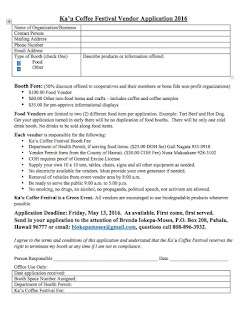 |
| Japanese hula sisters of Halau Hula O Leionalani, under the direction of Kumu Debbie Ryder, planted trees at Makanau during Merrie Monarch Festival Week. See more below. Photo from Debbie Ryder |
 |
| An HVO geologist uses a laser rangefinder to measure depth of the lava lake in the Overlook crater at Kilauea's summit. Photo from USGS/HVO |
During the deflation, seismic activity across the volcano did not change significantly, with fluctuations in summit tremor amplitudes related to spattering along edges of the lava lake as rocks broke loose and fell into the lake.
To read comments, add your own, and like this story, see facebook.com/kaucalendar.
MAKANAU AND PUNALU`U FISHPOND RESTORATION are among projects proposed by the Uhane Pohaku Na Moku O Hawai`i nonprofit led by Kawehi and Debbie Ryder. The group has applied for county grants “to help restore and preserve the Punalu`u ahupua`a,” makai and mauka.
“Our project will work with at-risk youth, ages 10-21, islandwide,” Uhane’s grant application states. Makai, the project includes “clearing vegetation growing over Ninoole and Hilo`e fishponds” and replacing them with coastal plants, according to the application. Future plans include a boardwalk around the ponds and using them for aquaculture education and farming, says the proposal.
“Our project will work with at-risk youth, ages 10-21, islandwide,” Uhane’s grant application states. Makai, the project includes “clearing vegetation growing over Ninoole and Hilo`e fishponds” and replacing them with coastal plants, according to the application. Future plans include a boardwalk around the ponds and using them for aquaculture education and farming, says the proposal.
Uhane’s mauka project is restoration of Makanau, which the group describes as being “rich in biological and cultural diversity.” The application states that the group wants to “teach the youth of its Hawaiian traditions so that the Hawaiian culture can continue to thrive in today’s youth, our next generation, so that they can continue to pass on the traditions of old.”
 |
| The heiau at Makanau is cared for by Demetrius Oliveira, of Pahala, under an agreement with Olson. Photo from Debbie Ryder |
Uhane requested $57,199 from the county for the projects, and County Council’s Human Services & Social Services Committee recommended $7,000. Other possible funding sources listed for the project are $346,994 for a state grant-in-aid and $75,000 from the state Office of Youth Services.
Uhane’s projects will be managed by new Executive Director Kawehi Ryder, said Debbie Ryder. She explained that former Uhane director Steven Pavao and former project contact person Roxanne Costa are no longer with Uhane. They were working with a Safe House for girls that was established by Uhane on `Ohi`a Street in Pahala, but the program has ended, Debbie Ryder explained. Now called Hale `Ohi`a, the former safe house will be use for other community and youth programs, she said.
She noted that Uhane recently hosted Family Court Judge Henry T. Nakamoto for a site visit to the farm that the organization is caring for in Wood Valley. She said that Uhane is applying to help youth through offering community service at the farm and other Uhane sites.
Regarding Makanau, she said that Uhane sends a “big mahalo a nui loa to Mr. Ed Olson for the right of entry access to Makanau for the Ka`u Community doing restoration work up at the Mauna.” The organization recently hosted Japanese hula sisters with Halau Hula O Leionalani, under the direction of Kumu Debbie Ryder, at Makanau during the Merrie Monarch Festival. Uhane has also been helping Demetrius Oliveira, of Pahala, with caring for the heiau under an arrangement between Edmund C. Olson and Oliveira.
To read comments, add your own, and like this story, see facebook.com/kaucalendar.
She noted that Uhane recently hosted Family Court Judge Henry T. Nakamoto for a site visit to the farm that the organization is caring for in Wood Valley. She said that Uhane is applying to help youth through offering community service at the farm and other Uhane sites.
Regarding Makanau, she said that Uhane sends a “big mahalo a nui loa to Mr. Ed Olson for the right of entry access to Makanau for the Ka`u Community doing restoration work up at the Mauna.” The organization recently hosted Japanese hula sisters with Halau Hula O Leionalani, under the direction of Kumu Debbie Ryder, at Makanau during the Merrie Monarch Festival. Uhane has also been helping Demetrius Oliveira, of Pahala, with caring for the heiau under an arrangement between Edmund C. Olson and Oliveira.
To read comments, add your own, and like this story, see facebook.com/kaucalendar.
 |
| Stargazers atop Makanau enjoy Ka`u's dark skies. Photo from Ka`u Coffee Festival |
VISITATION TO MAKANAU is allowed by appointment only. The Edmund C. Olson Trust allows community organizations to visit Makanau through requests, with consideration of the family ranching in the area and events and projects planned for the mountain. The schedule over the next two months includes a group from Kamehameha Schools and a stargazing event during the Ka`u Coffee Festival on Friday, May 20. Community groups wishing to schedule access to Makanau can call Olson Trust land manager John Cross at 987-4229.
For the stargazing event, participants will meet at Ka`u Coffee Mill and travel together to Makanau, where they discover Ka`u’s dark skies. Cross and others will speak of the history of lands below and the significance of Makanau and the night skies. To sign up, call 928-0550.
For more, see kaucoffeefest.com and kaucoffeemill.com.
To read comments, add your own, and like this story, see facebook.com/kaucalendar.
To read comments, add your own, and like this story, see facebook.com/kaucalendar.
AS MAUNA LOA SHOWS SIGNS OF UNREST, Hawaiian Volcano Observatory scientists discuss its spectacular 1950 eruption in the current issue of Volcano Watch.
“In March 1950, Mauna Loa inflation was so significant that tilt was recorded at the summit of Kilauea. Two months later, continuing deformation was accompanied by a sharp increase in small earthquakes, signaling the increased probability of an eruption.
“On May 29, an island-shaking magnitude-6.4 earthquake occurred beneath Mauna Loa's west flank. Sixty-four hours later, at 9:04 p.m., HST, on June 1, the eruption began, with fissures opening at the summit and uppermost Southwest Rift Zone of the volcano.
“The fissure eruptions quickly spread down rift—from 3,845 to 3,350 meters (12,600 to 11,000 feet) elevation—sending floods of lava to the west and southeast. Volcanic gas emissions fed a mushroom-shaped cloud up to 3,050 m (10,000 ft) high above the volcano's summit.
“In March 1950, Mauna Loa inflation was so significant that tilt was recorded at the summit of Kilauea. Two months later, continuing deformation was accompanied by a sharp increase in small earthquakes, signaling the increased probability of an eruption.
“On May 29, an island-shaking magnitude-6.4 earthquake occurred beneath Mauna Loa's west flank. Sixty-four hours later, at 9:04 p.m., HST, on June 1, the eruption began, with fissures opening at the summit and uppermost Southwest Rift Zone of the volcano.
“The fissure eruptions quickly spread down rift—from 3,845 to 3,350 meters (12,600 to 11,000 feet) elevation—sending floods of lava to the west and southeast. Volcanic gas emissions fed a mushroom-shaped cloud up to 3,050 m (10,000 ft) high above the volcano's summit.
“By 10:30 p.m., the Southwest Rift Zone had ‘unzipped’ down to an elevation of 2,380 m (7800 ft), unleashing an 18-km- (11-mi-) long trail of spectacular lava fountains that fed several large-volume, fast-moving lava flows. These flows reached the south Kona coast in about three hours, endangering lives, destroying property and severing the main highway and telephone lines along the way.
 |
| During Mauna Loa's 1950 eruption, three large, fast-moving lava flows flows advanced down its west flank and crossed Hwy 11 before reaching the ocean. USGS/HVO from Air National Guard |
“The eruption lasted 23 days and produced 376 million cubic meters (491 million cubic yards) of lava, with over 90 percent of that volume issued during the first six days of the eruption. With an eruption rate 200 times greater than that of Kilauea's current eruption, the 1950 Mauna Loa eruption produced more lava in six days than Pu`u `O`o typically erupts in over four years!
“Field observations and geologic sampling of lava from the entire extent of the 1950 fissures document changes in the lava chemistry and mineralogy over space and time during this phenomenal event.
“At elevations above 3,350 m (11,000 ft), the earliest 1950 fissures erupted comparatively low-temperature magma, cooled and partly crystallized within a shallow summit reservoir that presumably also fed earlier eruptions.
“As the 1950 eruption progressed, lower elevation fissures erupted increasing volumes of hotter and more ‘primitive’ magma with an abundance of minerals formed at high pressures and temperatures. These minerals crystallized from their host magma within the mantle (around 18 km, or 11 mi, deep) or were incorporated as magma rose through deep roots of the massive volcano—a sign that magma ascended quickly from great depths.
“Chemical zonation patterns of individual mineral crystals in the 1950 lava provide clues about the earliest stages of magmatic activity beneath the volcano. Crystals erupted from lower elevations indicate that magma began to ascend within the upper mantle up to 8 months before the eruption, and that the rate and amount of magma transport was increasing in the weeks prior to the eruption.
“Laboratory experiments were performed to test how long minerals formed at high pressures in the mantle could survive low pressures at shallow depths within Mauna Loa's magma chamber. Results show that some crystals erupted below 3,350 m (11,000 ft) could not have survived longer than a day in the shallow edifice—further testament to the unusually rapid ascent of magma immediately before the eruption began.
“During the 1950 Mauna Loa eruption, huge volumes of magma were transported rapidly from great depths with little warning of just how furious the eruption would be. Our findings suggest that key indicators of another such remarkable eruption might occur just hours before magma reaches the surface.”
“Laboratory experiments were performed to test how long minerals formed at high pressures in the mantle could survive low pressures at shallow depths within Mauna Loa's magma chamber. Results show that some crystals erupted below 3,350 m (11,000 ft) could not have survived longer than a day in the shallow edifice—further testament to the unusually rapid ascent of magma immediately before the eruption began.
“During the 1950 Mauna Loa eruption, huge volumes of magma were transported rapidly from great depths with little warning of just how furious the eruption would be. Our findings suggest that key indicators of another such remarkable eruption might occur just hours before magma reaches the surface.”
 |
| Register for KRHCAI's membership meeting and conference by tomorrow. |
To read comments, add your own, and like this story, see facebook.com/kaucalendar.
TOMORROW IS THE DEADLINE to register for Ka`u Rural Health Community Association’s 19th annual Membership Meeting & Conference. This year’s theme is Rural Health at Work in Our Communities. The event takes place Friday, April 15 from 8:30 a.m. to 1:30 p.m. at Pahala Community Center.
Register at 928-0101.
Register at 928-0101.
SUPPORT OUR SPONSORS AT PAHALAPLANTATIONCOTTAGES.COM AND KAUCOFFEEMILL.COM. KA`U COFFEE MILL IS OPEN SEVEN DAYS A WEEK.



 |
| See kaucalendar.com/TheDirectory2016.html. |
 |
| See kaucalendar.com/KauCalendar_April_2016.pdf. |


